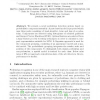Free Online Productivity Tools
i2Speak
i2Symbol
i2OCR
iTex2Img
iWeb2Print
iWeb2Shot
i2Type
iPdf2Split
iPdf2Merge
i2Bopomofo
i2Arabic
i2Style
i2Image
i2PDF
iLatex2Rtf
Sci2ools
DAGM
2009
Springer
2009
Springer
Pedestrian Detection by Probabilistic Component Assembly
We present a novel pedestrian detection system based on probabilistic component assembly. A part-based model is proposed which uses three parts consisting of head-shoulder, torso and legs of a pedestrian. Components are detected using histograms of oriented gradients and Support Vector Machines (SVM). Optimal features are selected from a large feature pool by boosting techniques, in order to calculate a compact representation suitable for SVM. A Bayesian approach is used for the component grouping, consisting of an appearance model and a spatial model. The probabilistic grouping integrates the results, scale and position of the components. To distinguish both classes, pedestrian and non-pedestrian, a spatial model is trained for each class. Below miss rates of 8% our approach outperforms state of the art detectors. Above, performance is similar.
DAGM 2009 | Image Processing | Probabilistic Component Assembly | Spatial Model | Support Vector Machines |
| Added | 26 May 2010 |
| Updated | 26 May 2010 |
| Type | Conference |
| Year | 2009 |
| Where | DAGM |
| Authors | Martin Rapus, Stefan Munder, Gregory Baratoff, Joachim Denzler |
Comments (0)

